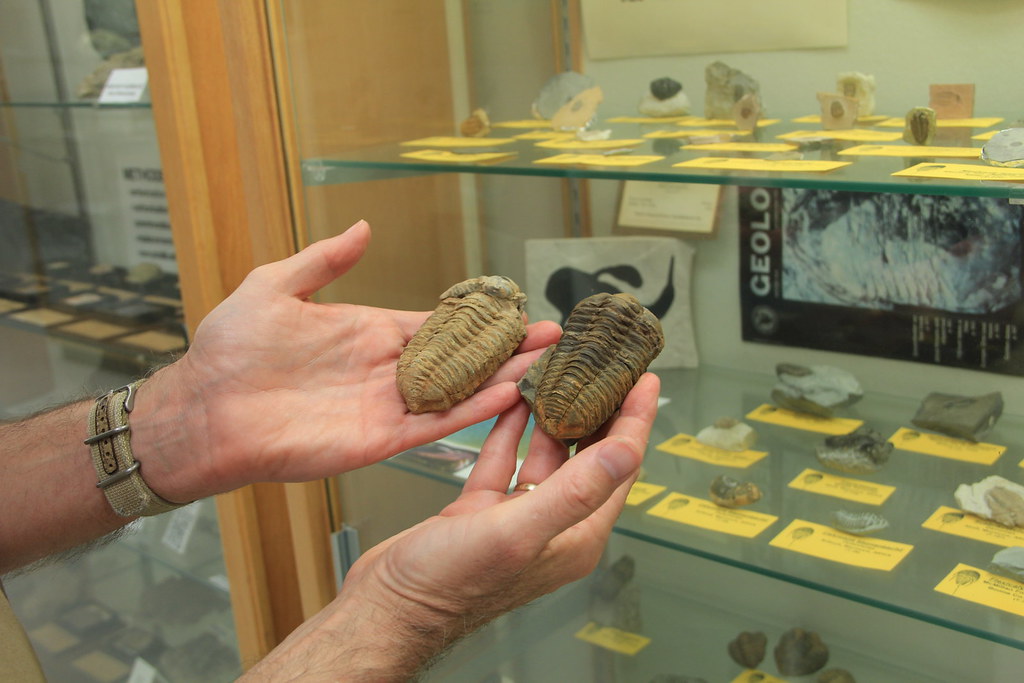The David J. Fitzgerald Museum of Earth Sciences
The David J. Fitzgerald Museum of Earth Science is an educational component of the Department of Environmental Science and Sustainability. This museum contains exhibits that display the findings of various minerals, fossils and other geological elements. Below is a sample of the many items collected over the years that have allowed students and staff to create the captivating museum we have today.
To see the collection in person, visit us in Garni Science Hall, Second Floor. There you will find maps and descriptive infographics that showcase all the samples featured within the cabinets.
Earth Explorer’s Nook
Volcano Experiment
Video created by St. Mary’s University Engineering Science major Magali Rodriguez.Rock Density Demo
Video created by Ana Diaz (B.S. ’24) from St. Mary’s University.
Specimen of the Month
April 2025: Pyrite (“Fools Gold”)
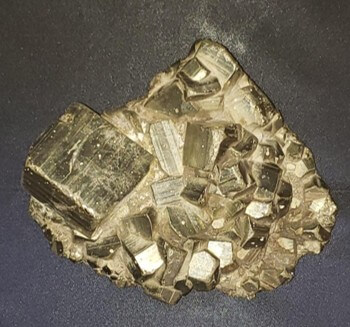
This April, we feature pyrite, commonly called “fool’s gold,” from our collection. Often confused with gold, pyrite can be distinguished by its hardness and streak color (USGS 2025a). Recognized for its metallic luster and cubic crystals, pyrite is an iron sulfide mineral of industrial significance, often explored in paleoenvironmental studies. Misleading many prospectors, pyrite is essential in understanding both geological and historical contexts. The sample displayed here is from the San Cristóbal Mine in Peru.
Pyrite forms unique cubic and pyritohedral crystals, often found in quartz within hydrothermal veins. Its small spherical clusters, known as framboids, indicate anoxic conditions in certain rocks (Hutchings and Turchyn 2021).
Geological settings that pyrite form in include hydrothermal veins and black shales, thriving in sulfide-rich, anoxic environments. It plays a role in coal seams and can contribute to environmental issues through acid mine drainage. Pyrite also has industrial value, particularly in its cobaltiferous form.
Historically, pyrite was vital for early fire-making. Today, it serves as a key source of sulfur for sulfuric acid, important in fertilizers and industrial applications (USGS 2025a). While it doesn’t have the same value as gold, this geological trickster still has many uses for humans today.
References:
Hutchings AM, Turchyn AV. 2021. A quantification of the effect of diagenesis on the paleoredox record in mid-Proterozoic sedimentary rocks. Geology. 49(9):1143–1147. https://doi.org/10.1130/G48774.1
United States Geological Survey. 2025a. What is fool’s gold? [accessed 2025 Mar 19]. Available from: https://www.usgs.gov/faqs/what-fools-gold.
United States Geological Survey. 2025b. Science snippet: Pyrite and industrial uses. [accessed 2025 Mar 19]. Available from: https://www.usgs.gov/news/science-snippet/golden-rule-april-fools.
Past Featured Specimens
March 2025: Trilobites
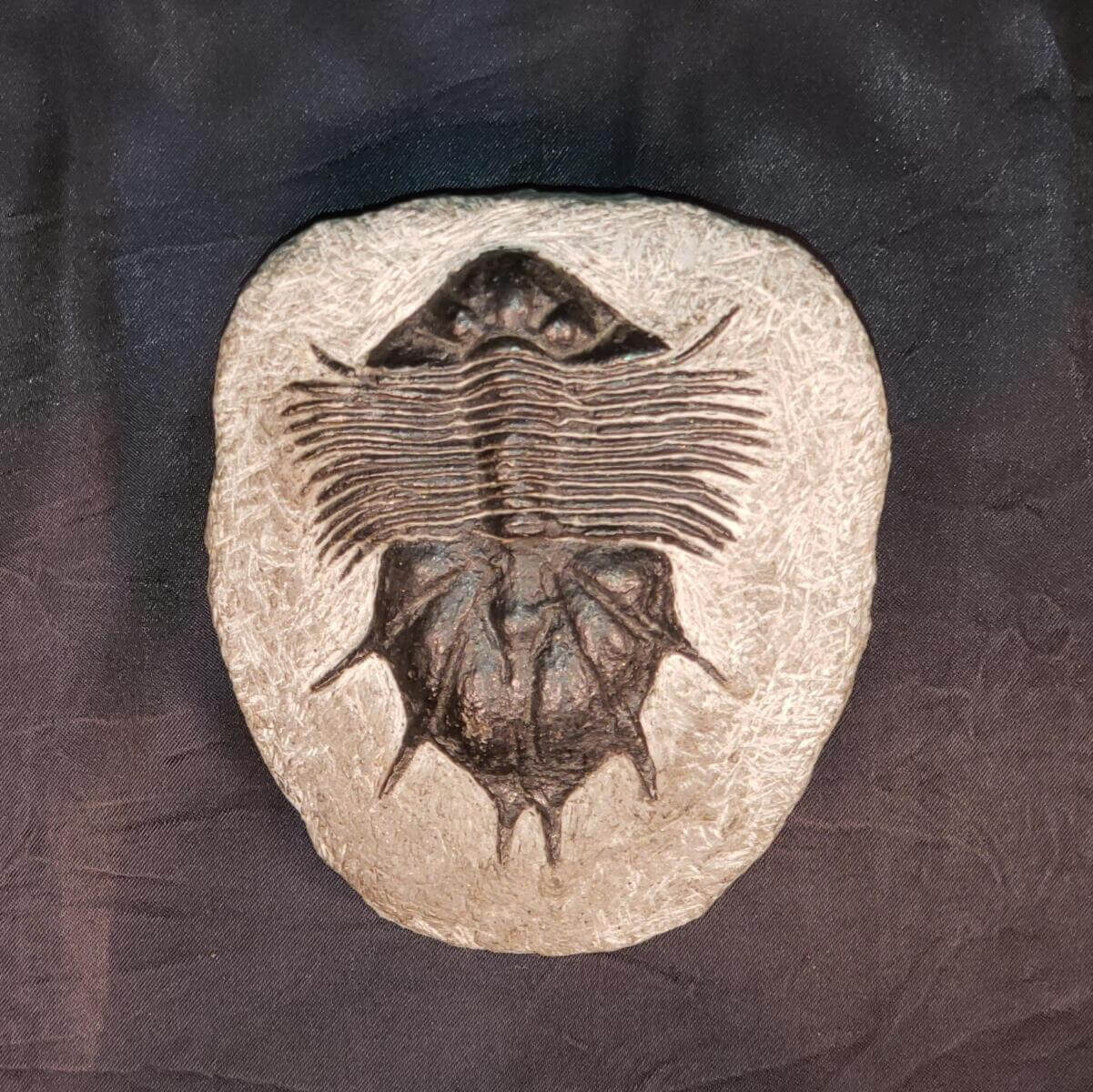
The David Fitzgerald Museum contains a wide variety of trilobite species including the two shown here. The trilobite genera Acanthopyge sp. and Kaskia chesterensis belong to distinct evolutionary lineages but share paleogeographic and environmental similarities.
Acanthopyge sp. is known from various Devonian to Carboniferous deposits worldwide (Beecher 1898). Acanthopyge sp., particularly Acanthopyge consanguinea, has been extensively studied in the context of its protaspid larval stages and adult morphology. Unlike Kaskia chesterensis, which shows transitional features within Proetidae, Acanthopyge sp. exhibits more specialized characteristics, including pronounced spinosity and a highly segmented pygidium. These traits suggest adaptation to deeper or more turbulent marine environments. The study of Acanthopyge consanguinea by Beecher (1898) highlights the taxonomic complexity of this genus, demonstrating how morphological variations within Acanthopyge sp. could reflect ecological specialization or evolutionary divergence.
Acanthopyge consanguinea, has been identified from multiple localities, including North America, Europe and North Africa, spanning from the Devonian to the Mississippian time period. The presence of Acanthopyge sp. in geographically close formations to Kaskia chesterensis suggests that both trilobites coexisted within related but possibly distinct ecological niches. Notably, Acanthopyge species are often found in deepwater shale or fine-grained limestone deposits, hinting at different environmental preferences compared to the more shallow-dwelling Kaskia chesterensis (Beecher 1898).
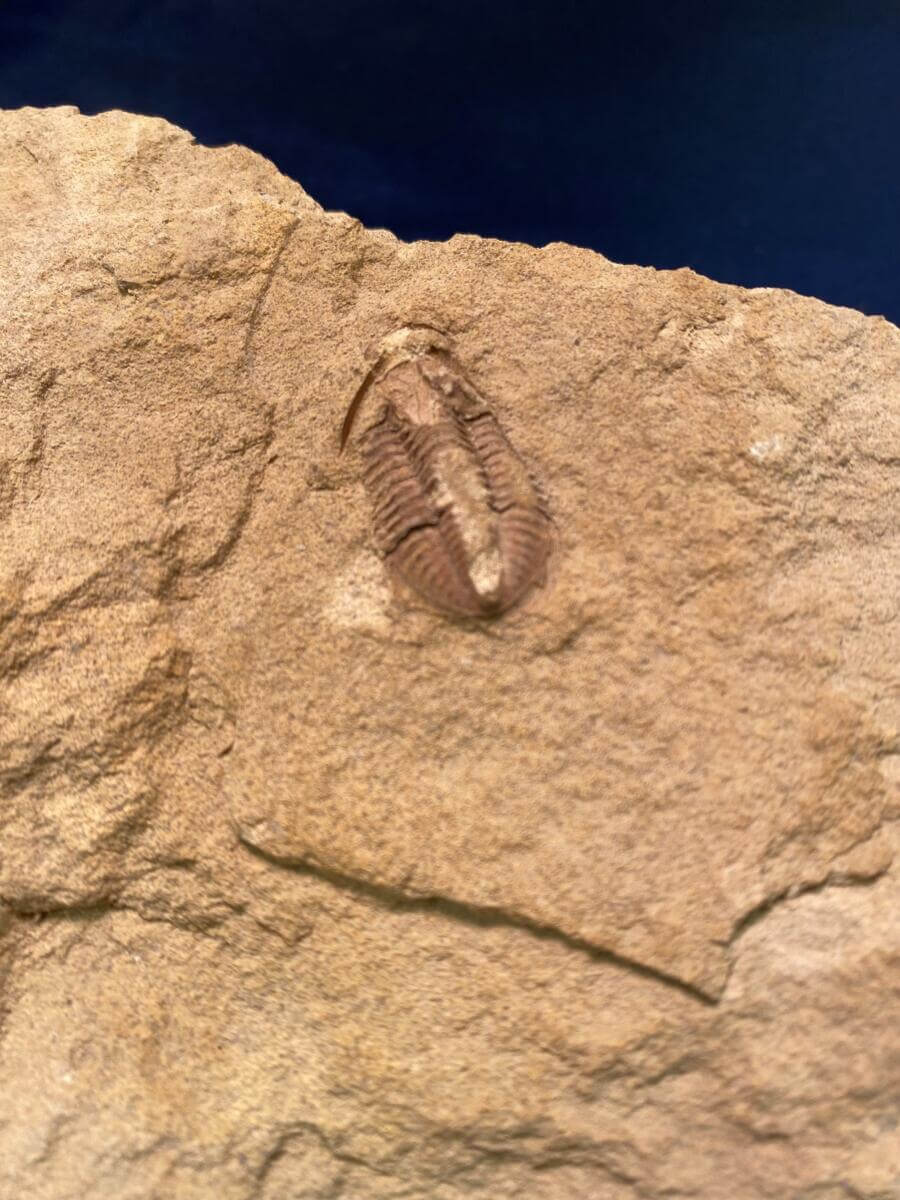
Kaskia chesterensis, described by Weller (1936), is a well-documented species from the Chesterian Series of the Mississippian in North America. Fossil evidence places Kaskia chesterensis in Chesterian deposits of Illinois, Kentucky, Oklahoma and West Texas, indicating its widespread distribution across Mississippian carbonate platforms. The species is often found in fine-grained limestone associated with brachiopods and crinoids, suggesting a stable, shallow marine ecosystem (WVGS 2025).
Kaskia chesterensis is recognized for its broad cephalon, long genal spines and a well-defined pygidium with up to 17 axial segments. These features position it as an intermediate form bridging the Griffithides and Paladin genera, representing an evolutionary shift within the Proetidae family. The cephalon is broad and rounded, with long acute genal spines extending nearly the entire length of the thorax. The glabella is inflated and well-arched, exhibiting faint lateral furrows and a narrow or absent frontal border—key distinctions from the Paladin genus. Its well-defined pygidium has a high axial lobe with up to 17 segments, giving it a robust appearance (Weller 1936).
While Kaskia chesterensis and Acanthopyge sp. belong to separate lineages, their fossil distributions suggest that they occupied comparable marine ecosystems. Their relative locations highlight the dynamic nature of trilobite evolution and dispersal across marine transgressive environments over time. The correlation between these trilobites suggests a divergence within the proetid lineage, where Kaskia chesterensis occupied warm, shallow marine habitats, while Acanthopyge sp. may have thrived in more variable or deeper settings.
References:
Weller, J. M. 1936. Carboniferous Trilobite Genera. Journal of Paleontology. 10(8):704–714. [accessed 2025 Feb. 21]. https://www.jstor.org/stable/1298412.
Whittington HB, Beecher. 1956. Beecher’s Lichid Protaspis and Acanthopyge consanguinea (Trilobita). Journal of Paleontology. 30(5):1200–1204. [accessed 2025 Feb. 21]. https://www.jstor.org/stable/1300618.
WVGES Museum: Kaskia chesterensis. 2022. Wvnetedu. [accessed 2025 Feb. 21]. https://www.wvgs.wvnet.edu/www/museum/musenew2.htm.
March 2025: Trilobites
February 2025: Bumblebee Jasper

The bumblebee jasper, also known as eclipse jasper and orpiment, is a more distinctive and colorful form of the usual jaspers and its use is also different due to the aesthetics. But the bumblebee jasper is notoriously known for its colorfully banded and dramatic color palette which contains bright yellow, black, dark brown, orange and sometimes even dark red, hence its name. Due to the fact that its colors are very attractive, the bumblebee jasper is used by lapidarists, artists and jewelers to make cabochons, mixed art media, carvings, mosaic work, house decor, sculptures and jewelry. The bumblebee jasper is primarily made out of calcium carbonate, sulfur, realgar and manganese oxides. Because bumblebee jaspers are mostly sourced from Indonesia, on the island of Java and are formed in volcanic environments, their geology is quite interesting (MAT 2023). The deposits are typically found next to fumaroles.
Fumaroles are openings in the surface of the earth which produce steam and gases like carbon and sulfur dioxide. These openings happen when magma rises enough and situates itself in the earth’s crust without erupting and the fumaroles keep emitting gases and steam depending on how long the magma awaits to completely rise to the surface (USGS 2015). These geological circumstances contribute to the bumblebee jasper’s distinctive and unique chemistry, as well as its dramatic color palette.
MAT M. Nov. 30, 2023. Bumble Bee Jasper : Properties, Formation, Locations» Geology Science. Geology Science. [accessed 2025 Jan 27].
https://geologyscience.com/gemstone/bumble-bee-jasper/.
Oct. 5, 2015. USGS Communications and Publishing. EarthWord: Fumarole.
https://www.usgs.gov/news/earthword-fumarole
February 2025: Bumblebee Jasper
January 2025: Texas Wild Hogs: Sus scrofa
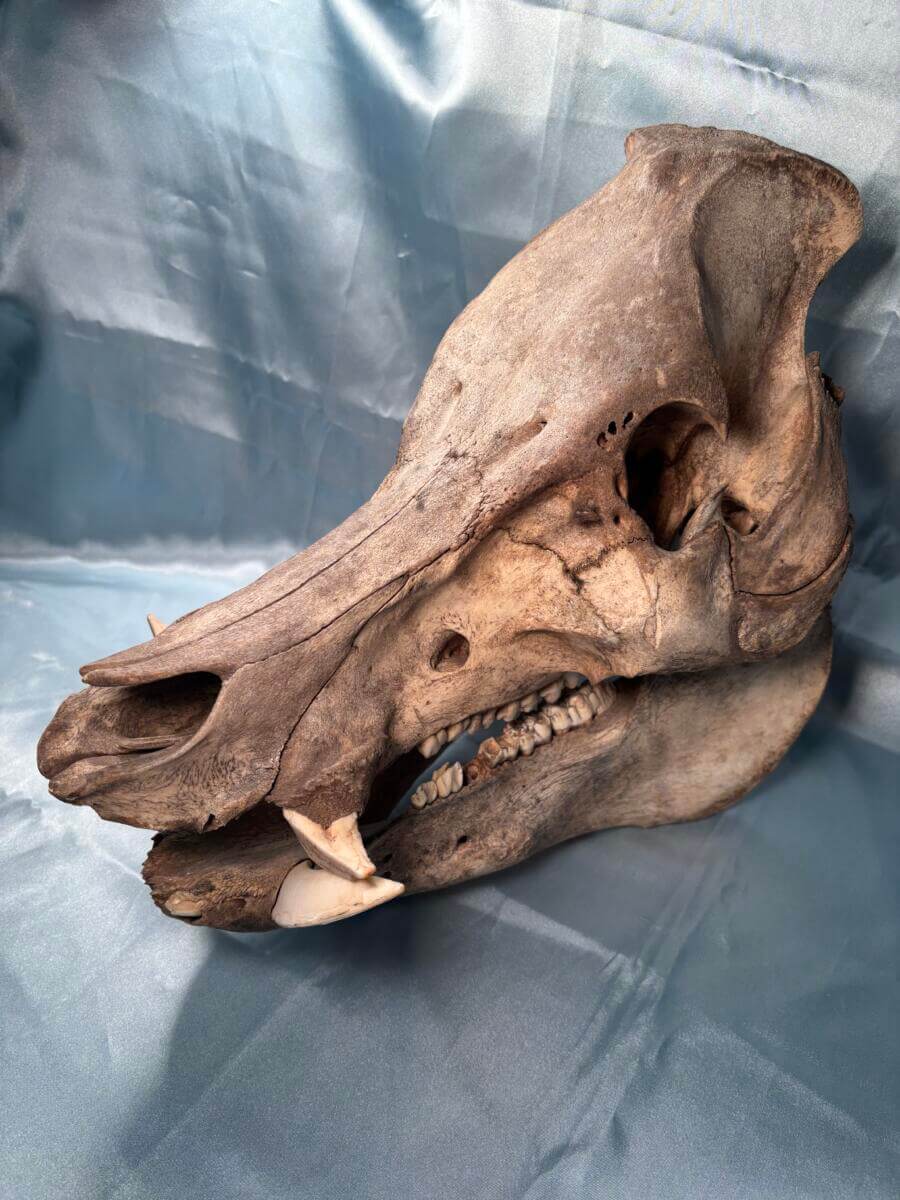
In our ecology case in the Fitzgerald Museum we have recently added the skull of Sus scorfa, known commonly as the Wild Hog in Texas. Sus scrofa is a species that is not native to the continent of North America. However, wild hogs are occasionally mistaken with Javelinas in Texas even though Javelinas are actually a native species to the Southwest of the United States. In fact, Christopher Columbus carried Sus scorfa to the West Indies in 1493 and, by 1539, to the United States. The first feral hogs were brought over by the Spanish explorers in boats, but because the hogs were not needed anymore, they were eventually abandoned (Taylor). This caused the wild boars to adapt to their new environment, which without natural predators, led to the mass reproduction of this exotic invasive species. The predation rate by natural predators for hogs is 25% in Europe and in Asia, but in the United States humans are the only hunters in North America (Kinsey 2020). There is a myriad of wild hogs in Texas, with slight differences in fur color and print patterns, but it is important to not confuse them with Javelinas (Mapston 2004). There are several characteristics that Javelinas possess that distinguish them from wild hogs. For example, Javelinas do not have a visible tail and both males and females have a “collar” of white and black fur around their shoulders and necks. Many Javelinas have deteriorated and broken teeth due to age, have small eyes and have small bodies as well. Javelinas are much smaller than hogs, measuring only approximately 12 inches tall. Although there has been documentation of Javelinas weighing 50 to 60 pounds (Taylor & Synat) most are much smaller than hogs weighing approximately 35 to 45 pounds.
Works Cited
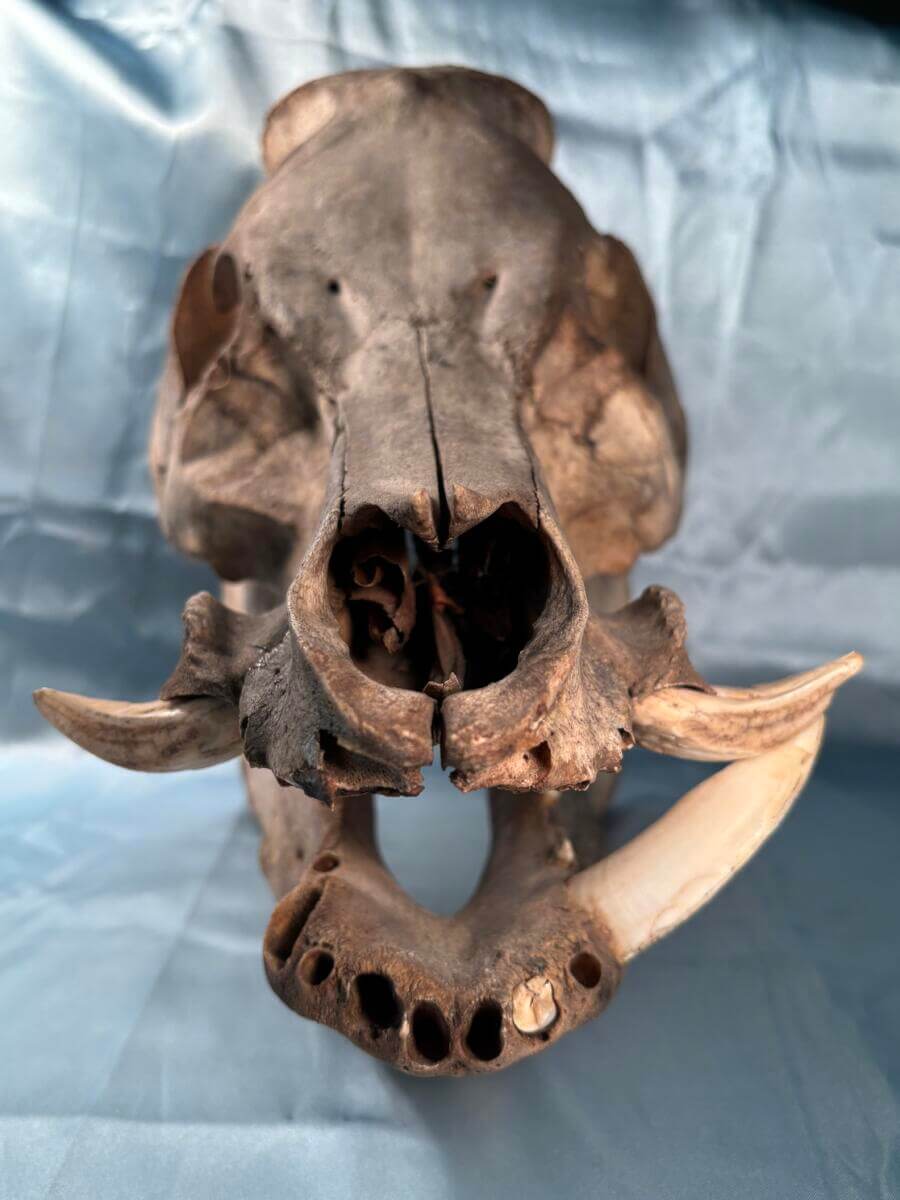
Kinsey, J. 2020. TPWD: Feral Hogs. Texasgov. [accessed 2024 Sep 26]. https://tpwd.texas.gov/huntwild/wild/nuisance/feral_hogs/
Mapston, M. 2004. Feral Hogs in Texas. [accessed 2024 Sep 19]. https://tfsweb.tamu.edu/uploadedFiles/TFSMain/Manage_Forest_and_Land/Wildlife_Manageme nt/Non-Game/Feral_hogs_TCE.pdf
Taylor, R. TPWD: The Feral Hog in Texas. [accessed 2024 Sep 19]. https://tpwd.texas.gov/publications/pwdpubs/media/pwd_bk_w7000_0195.pdf
Taylor, R. Synat, D. TPWD: The Javelina in Texas. [accessed 2024 Nov 15].
January 2025: Texas Wild Hogs: Sus scrofa
December 2024: Pink Barite

Pink barite, a striking variation of the mineral barite, is characterized by its distinct coloration and significant applications across various industries. Barite itself is a naturally occurring barium sulfate mineral, typically appearing in shades of white or colorless, but also manifesting in hues such as pink, blue, brown, gray, green, red and yellow. The mineral’s high density and chemical inertness render it particularly valuable for numerous applications. In the medical field, a high-purity form of barite is employed for gastrointestinal imaging, where it enhances the visibility of the digestive tract on x-rays due to its ability to obstruct x-ray penetration. This allows healthcare professionals to assess both normal and abnormal anatomical structures effectively. In the drilling industry, barite plays a crucial role as a weighting agent in drilling mud formulations. Its high specific gravity increases the hydrostatic pressure of the mud, which is essential for counteracting high-pressure zones encountered during drilling operations. Furthermore, barite’s softness minimizes wear on drilling equipment and facilitates lubrication. Beyond these primary uses, barite finds application in diverse products including plastics, rubber mudflaps, clutch pads, paint and even sound-deadening materials in automobiles. Notably, the barite desert rose, a unique formation found predominantly in Oklahoma, highlights the mineral’s aesthetic appeal and geological significance, leading to its designation as the official state rock. Overall, barite’s versatility, combined with its intriguing physical properties and environmental safety, solidifies its importance in both industrial and medical contexts.
Application of Barite in Drilling Mud – TEAMChem. 2023 Jul 5. teamchem.
https://www.teamchem.co/blog/application-of-barite-in-drilling-mud.
Barite: A Naturally Occurring Mineral Vitally Used in Different Industries. wwwresearchdivecom. https://www.researchdive.com/blog/Barite-A-Naturally-Occurring-Mineral-Vitally-Used-in-Different-Industries.
Rose Rock | The Encyclopedia of Oklahoma History and Culture. Oklahoma Historical Society | OHS. https://www.okhistory.org/publications/enc/entry?entry=RO030.
December 2024: Pink Barite
November 2024: Muscovite

Muscovite or white mica, is the most common mica mineral. This mineral is usually colorless, although it can have a soft pale green tint to it and is slightly pleochroic. Muscovite often appears in tabs or long skinny flakes which may be bent due to its fragility. It is a contrast of metamorphic rock resulting from the alteration of topaz, feldspar, kyanite, etc., where it typically forms crystals and plates. Muscovite has characteristics of peraluminous rocks and is found in most granites, pegmatites, gneisses and schists. As stated by the University of Minnesota, before humans learned to make glass from quartz, windowpanes were formed from large sheets of muscovite, even though they were not perfectly transparent. While we no longer use muscovite windows, this mineral is widely used throughout the electric and construction industries, even making a special appearance in the cosmetic department. Muscovite can also be used as a filler for paints. Muscovite can be found in the Upper Midwest. Central and Northern Minnesota and Wisconsin are the most common states to find Muscovite because of the states’ granite and metamorphic rock.
Muscovite: The Glittering Ancient | Montana Natural History Center. wwwmontananaturalistorg. https://www.montananaturalist.org/blog-post/muscovite-the-glittering-ancient/.
Muscovite | Common Minerals. commonmineralsesciumnedu.
https://commonminerals.esci.umn.edu/minerals-g-m/muscovite.
Marketing E. 2020 Mar 11. What is muscovite mica and what is it used for? Elmelin Ltd.
https://elmelin.com/what-is-muscovite-mica/#:~:text=Muscovite%20is%20pearlescent%2C%20which%20means.
November 2024: Muscovite
October 2024: Apophyllite with Stilbite and Chalcedony

The photograph to the right shows a combination of minerals Apophyllite, which is shown as the green cubical structures and Stilbite which is the pink banded nodules or “Bow Tie” form in between. A white chalcedony on the sample’s back is not visible in this image. The minerals in this sample that are clustered together belong to the zeolite group. Apophyllite can be green, pink, yellow, violet and white. It is desired by collectors due to its colors. Stilbite can come in white or pink and can also be vitreous. It is desired for its “wheat sheaf” form, the bow tie. Chalcedony has a waxy and dull appearance and can be white, gray and blue, but it is not uncommon for chalcedony to be multicolored. Chalcedony has varied formation habitats, for example, they can be found in geodes and form pseudomorphs after organic material. It is often used as an ornamental stone due to its varieties: Moss Agate, Carnelian, Tiger’s Eye, Sard, Bloodstone, Agate and the most costly Chrysoprase.
There are many places throughout the United States where these lovely specimens can be found, but here are a few places that can be visited in Texas. Chalcedony is at Alibates Flint Quarries National Monument, in Potter County, Texas. Apophyllite can be found in Bee Mountain, near Big Bend National Park and stilbite can be seen in the Davis Mountains, in Brewster county, Texas. This specimen was generously donated to the Fitzgerald Earth Science Museum by John and Kathi Oppenheimer.
References
Apophyllite: The mineral apophyllite information and pictures. wwwmineralsnet. [accessed 2024 Sep 26] https://www.minerals.net/mineral/apophyllite.aspx.
Apophyllite Group. wwwmindatorg. [accessed 2024 Sep 26] https://www.mindat.org/min-283.html .
Big Bend National Park (U.S. National Park Service). 2017. Npsgov. https://www.nps.gov/bibe/index.htm.
Chalcedony: Mineral information, data and localities. wwwmindatorg. [accessed 2024 Sep 26] https://www.mindat.org/min-960.html.
Chalcedony quartz: The mineral Chalcedony information and pictures. 2019. Mineralsnet. https://www.minerals.net/mineral/chalcedony.aspx.
Davis Mountains State Park — Texas Parks & Wildlife Department. tpwdtexasgov. [accessed 2024 Sep 26] https://tpwd.texas.gov/state-parks/davis-mountains.
Fritch MAPOB 1460, Us T 79036 P 806 857-6680 C. Alibates Flint Quarries National Monument (U.S. National Park Service). wwwnpsgov. [accessed 2024 Sep 26] https://www.nps.gov/alfl/index.htm.
Stilbite: The zeolite mineral stilbite information and pictures. wwwmineralsnet. [accessed 2024 Sep 26] https://www.minerals.net/mineral/stilbite.aspx.
Texas State Historical Association. Bee Mountain (Brewster County). Handbook of Texas. [accessed 2024 Sep 26]. https://www.tshaonline.org/handbook/entries/bee-mountain-brewster-county-RJB83.
October 2024: Apophyllite with Stilbite and Chalcedony
September 2024: Chrysocolla
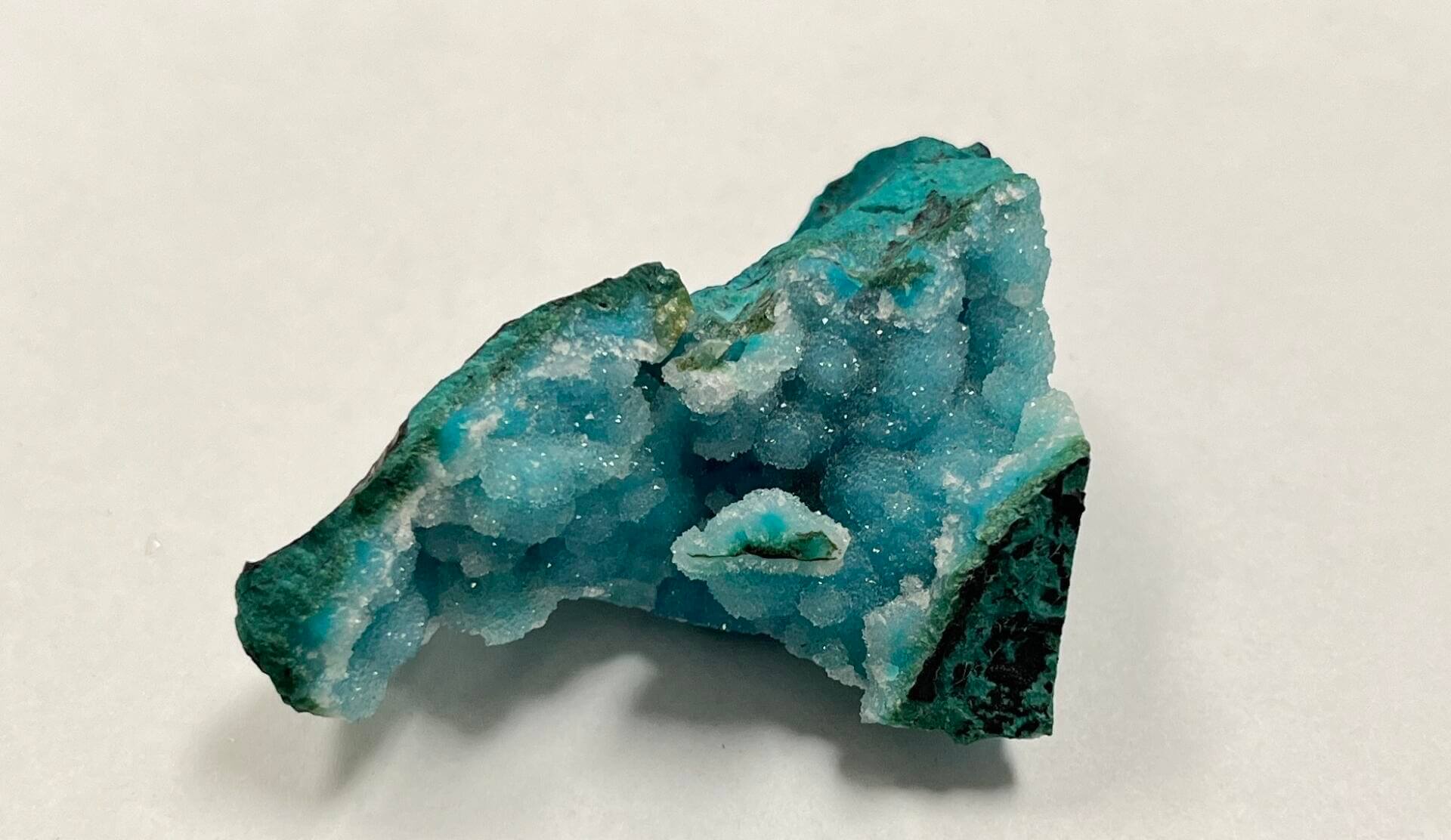
This beautiful cyan-colored gem has an interesting history dating back to Greek Civilization. First named by Theophrastus, a Greek philosopher and botanist, in 315 B.C, the name was derived from the Greek words chrysos, meaning gold and kola, meaning glue, referencing the fact that chrysocolla was employed from the earliest times by goldsmiths as an ingredient for solder, called santerna by the Romans, to weld gold pieces together.
Chrysocolla is a minor ore of copper and it forms in the oxidation zones of copper ore bodies. Azurite, malachite and cuprite are other common minerals that form in the same environment. One location where this mineral is currently found is in the Ray Mine near Kearny, Arizona and the Kennecott Copper Mine in Utah. Both sites are massive porphyry deposits that have been mined to provide the copper resources that we use in our society.
To learn more about copper mining and its place in the history of our country, the website for Kennecott Mines National Historic Landmark in Wrangell-St. Elias National Park, Isle Royal National Park and Keweenaw National Historical Park in Michigan. You can also learn more about the Geology of Wrangell-St. Elias to find out the conditions in which these minerals form. If you ever get to visit Kennicott Mines NHL, you can see many common copper minerals in the tailings piles on site.
References
Archaeological History of Isle Royale and Ancient Copper Mining (U.S. National Park Service). wwwnpsgov. https://www.nps.gov/articles/000/archaeological-history-ancient-copper-mining.htm.
Park MAW-SEN, Center PPB 439 M 106 8 RHC, Us A 99573 P 907 822-5234 C. Kennecott Mines National Historic Landmark – Wrangell – St Elias National Park & Preserve (U.S. National Park Service). wwwnpsgov. https://www.nps.gov/wrst/learn/historyculture/kennecott-mines-national-historic-landmark.htm.
Park MAW-SEN, Center PPB 439 M 106 8 RHC, Us A 99573 P-5C. Geology – Wrangell – St Elias National Park & Preserve (U.S. National Park Service). wwwnpsgov. https://www.nps.gov/wrst/learn/nature/geology.htm.
Ray Mine near Kearny. 2018 May 22. AZGS. https://azgs.arizona.edu/photo/ray-mine-near-kearny.
Timeline of Michigan Copper Mining Prehistory to 1850 – Keweenaw National Historical Park (U.S. National Park Service). 2016. Npsgov. https://www.nps.gov/kewe/learn/historyculture/copper-mining-timeline.htm.
Wikipedia Contributors. 2024 Jul 25. Chrysocolla. Wikipedia. [accessed 2024 Aug 28]. https://en.wikipedia.org/wiki/Chrysocolla#:~:text=in%20315%20BC.-.
September 2024: Chrysocolla
August 2024: Tufa
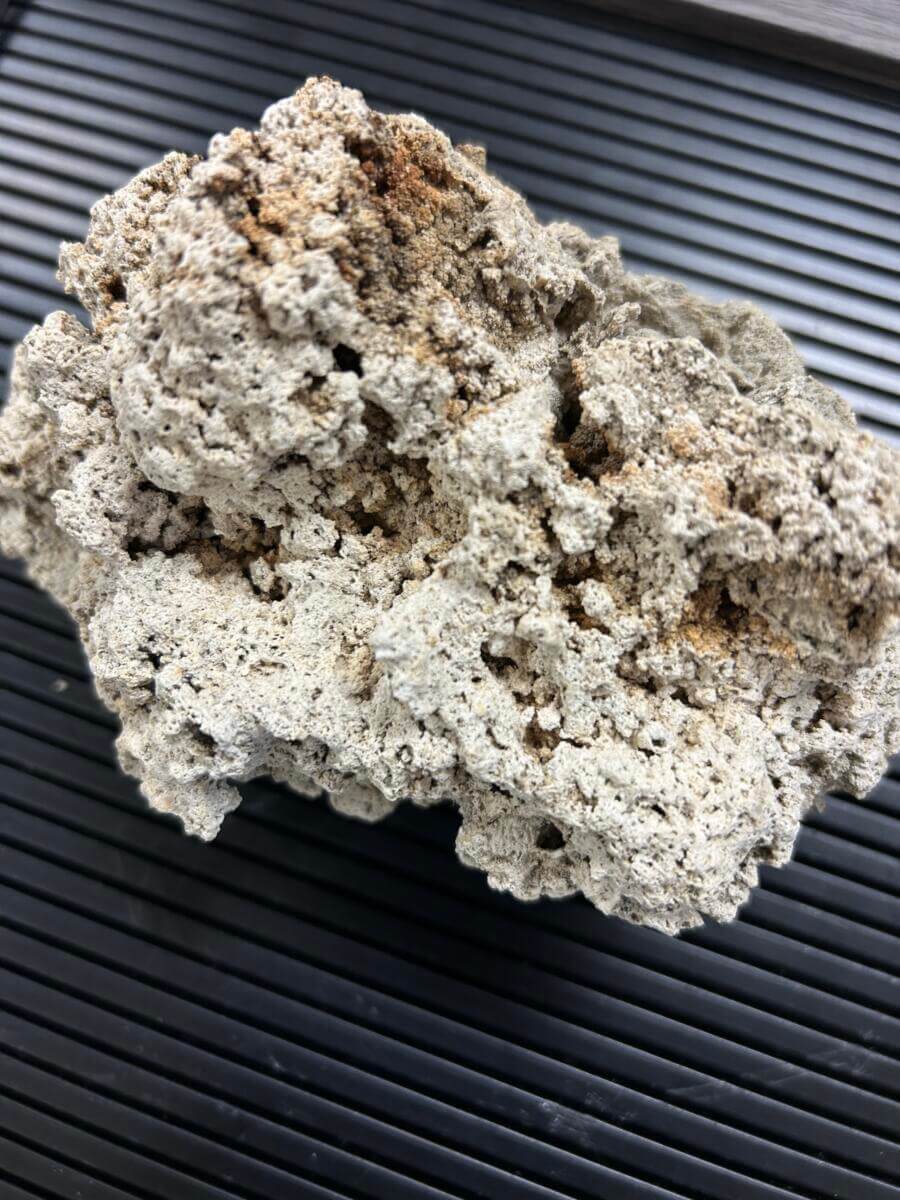
Tufa, “spongy” in appearance, is a unique type of limestone rock formed by precipitation of calcium carbonate from mineral-rich water sources, typically found in limestone-rich regions or areas with geothermal activity. This porous and lightweight rock is created as mineral-laden water flows through porous limestone or emerges from hot springs, carrying dissolved calcium carbonate to the surface. As the water evaporates or loses carbon dioxide, calcium carbonate is deposited, gradually building up tufa layers over time. Additionally, tufa formations provide important habitats for diverse ecosystems, supporting unique plant and animal life in their crevices and niches.
Mono Lake Tufa State Natural Reserve in California is known for its tufa towers. In this area, the towers formed when groundwater saturated with calcium carbonate moved into the lake, causing the tufa to form in the high-salinity water. Similar features can be found in Pyramid Lake and Soda Lakes in Nevada, where saline waters play a part in the tufa formation.
Examples of hot springs-influenced tufa are well displayed in Hot Springs National Park in Arkansas. Here, where geothermally heated waters move up through the Ouachita Mountains, limestone is dissolved and deposited where springs exit the ground. This is especially well exhibited on the Tufa Terrace Trail.
Hot Springs Geology – Hot Springs National Park (U.S. National Park Service). 2016. Npsgov. [accessed 2024 May 7] https://www.nps.gov/hosp/learn/nature/hotsprings.htm.
Long Valley Caldera Field Guide – Mono Lake | U.S. Geological Survey. wwwusgsgov. [accessed 2024 May 7]. https://www.usgs.gov/volcanoes/long-valley-caldera/science/long-valley-caldera-field-guide-mono-lake.
Pyramid Lake Nevada | The official site for the Pyramid Lake Paiute Tribe, Nevada. 2019. Pyramidlakeus.[accessed 2024 May 7] https://pyramidlake.us/.
Soda Lakes | U.S. Geological Survey. wwwusgsgov. [accessed 2024 May 7] https://www.usgs.gov/volcanoes/soda-lakes.
Tufa Terrace Trail (U.S. National Park Service). wwwnpsgov. [accessed 2024 May 7]. https://www.nps.gov/thingstodo/tufa-terrace-trail.htm.
- Birefringence in Calcite Crystals. Nikon’s MicroscopyU. [accessed May 6, 2024] https://www.microscopyu.com/tutorials/birefringence-in-calcite-crystals.
- Viking Sunstone – Iceland Spar – Facts and Sources. 2021 May 25. [accessed May 6, 2024] Nordic Culture. https://skjalden.com/viking-sunstone/.
August 2024: Tufa
July 2024: Iceland Spar
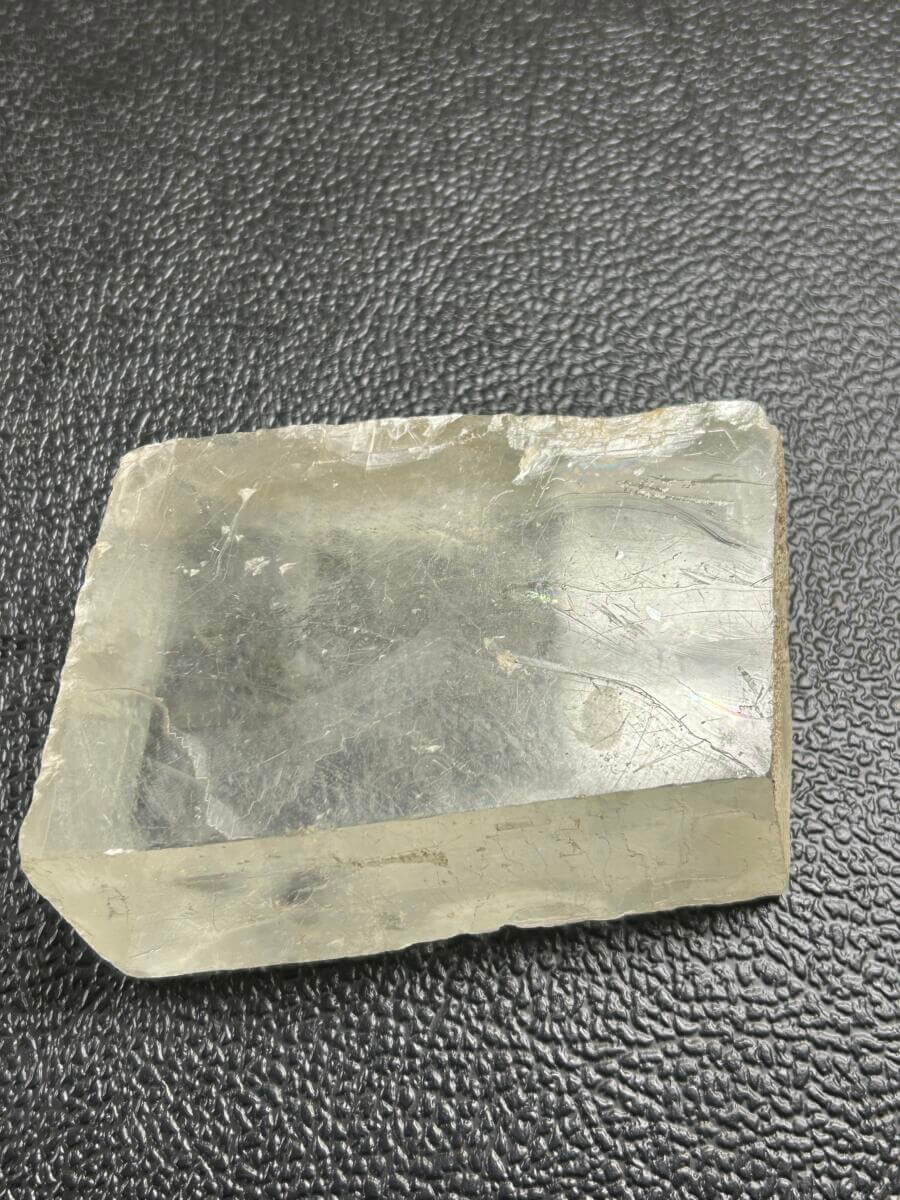
On a hot July day, we often find ourselves thinking of cooler places. This month, we are focusing on Iceland spar, a fascinating variety of calcite known for its optical wonders. Also referred to as optical calcite or rhombohedral calcite, Iceland spar was first identified in Iceland, which is how it got its name. Though it can be found worldwide under suitable geological conditions, Iceland spar is composed of calcium carbonate, just like other forms of calcite, but is typically transparent in this form.
Iceland spar has many uses, including its unique property of double refraction or birefringence. When viewed through this mineral, you see a double image due to the light splitting into multiple paths. This characteristic has historically been significant in the study of optics.
Iceland spar is also known as Viking stone. It is believed that the Vikings used it for navigation, as its polarizing ability allowed them to locate the sun even in poor weather. While Iceland spar is no longer widely used in navigation, it continues to hold scientific and industrial importance. It is utilized in optical instruments, polarizing microscopes and various scientific experiments where its optical properties are valuable.
References:
- Birefringence in Calcite Crystals. Nikon’s MicroscopyU. [accessed May 6, 2024] https://www.microscopyu.com/tutorials/birefringence-in-calcite-crystals.
- Viking Sunstone – Iceland Spar – Facts and Sources. 2021 May 25. [accessed May 6, 2024] Nordic Culture. https://skjalden.com/viking-sunstone/.
July 2024: Iceland Spar
June 2024: Ophiuroid (Brittle Sea Star)
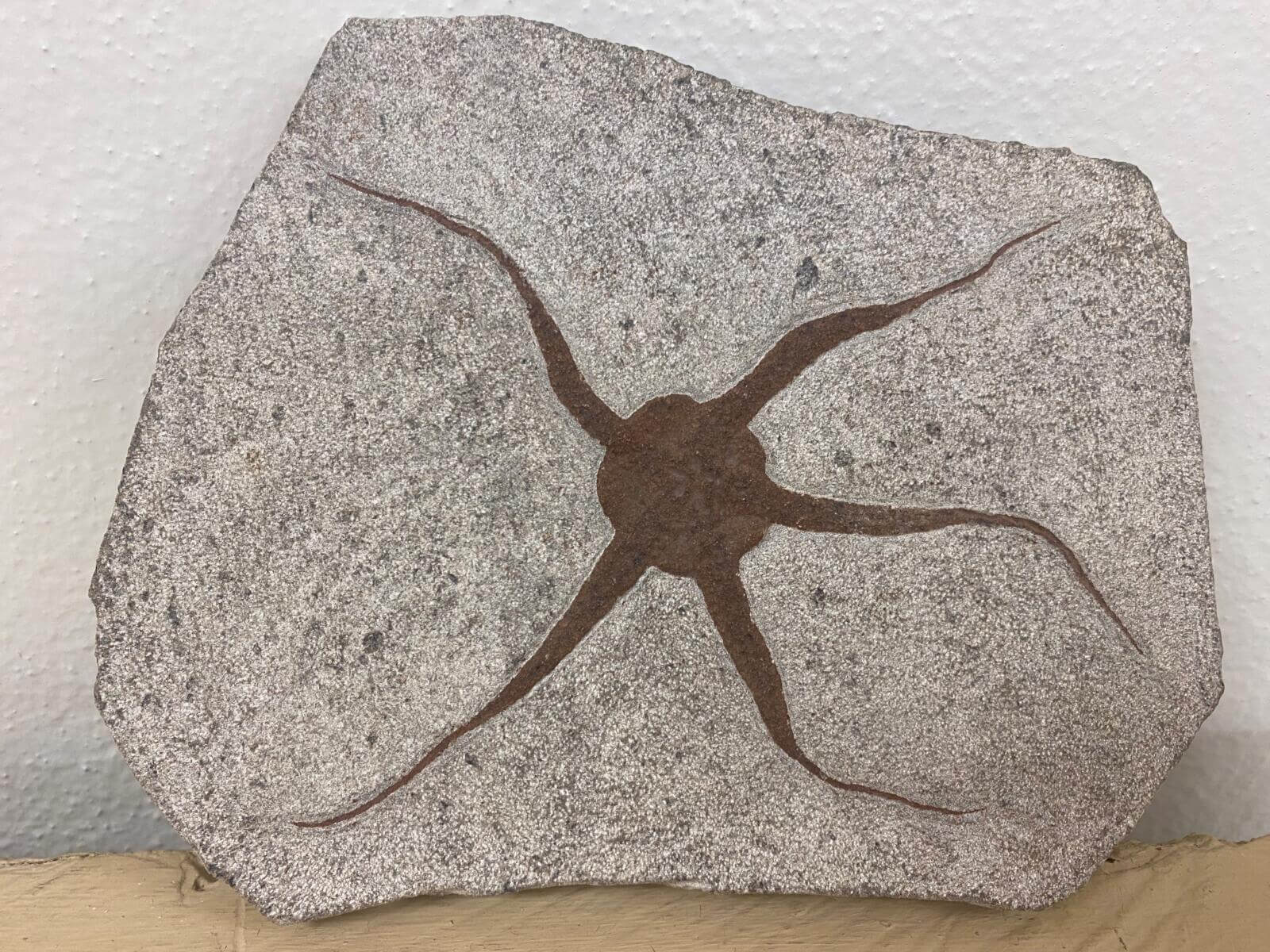
With summer starting, it is time to think about hitting the beach. In the Fitzgerald Earth Science Museum, we have many specimens that relate to marine and coastal areas. Among these is an interesting fossil of an Ophiuroid, commonly known as the Brittle Sea Star.
Ophiuroidea are well documented as having a long history on Earth, appearing first in the Ordovician period roughly 500 million years ago. Their fossils are uncommon finds as the creatures tended to fall to pieces quickly after the end of their life. The specimen shown here has a well-defined disk-shaped body with long flexible arms that allowed the animal to move by rapidly wriggling the arms in the water.
Ophiuroidea are in the class of echinoderms and are closely related to modern starfish. Many species of modern Ophiuroidea are present in the world’s oceans today. They are well adapted to a variety of environments and can live in brackish water allowing them to live in areas with a mixture of fresh and ocean water. In some habitats they are so prolific that they carpet the ocean floor. Ophiuroidea also have the ability to lose and regrow arms if they need to get away from a predator. To learn more about living brittle stars, watch Facts: The Brittle Star.
Facts: The Brittle Star. wwwyoutubecom. [accessed 2024 May 7].
https://www.youtube.com/watch?v=ST63vr_9woY&t=34s.
Ophiuroidea. Digital Atlas of Ancient Life. [accessed May 7, 2024] https://www.digitalatlasofancientlife.org/learn/echinodermata/ophiuroidea/.
The Ophiuroidea. ucmpberkeleyedu. [accessed May 6, 2024]
https://ucmp.berkeley.edu/echinodermata/ophiuroidea.html.
June 2024: Ophiuroid (Brittle Sea Star)
May 2024: Kyanite (Minas Gerais, Brazil)
Kyanite is a mineral composite of aluminum silicate, belonging to the silicate mineral group. Kyanite forms as a metamorphic rock under high pressure and temperatures of 350 – 600 ˚C. The distinct metamorphic conditions to produce kyanite can be found in mountain building environments and kyanite is a polymorph of andalusite and sillimanite. Additional regions where this mineral can be found include sections of the Himalayas Mountains (Asia), the Alps Mountains (Europe), the Appalachians Mountains (North America). A distinct characteristic in identifying kyanite is its crystal structure of long bladed crystals, with the colors ranging from hues of blue, white and gray. Kyanite structure and the differing hues makes pleochroism (the absorbing of different wavelengths of light due to the direction of the incoming light and polarization) occur, highlighting different colors when viewed from different angles.
Today kyanite is collected by rock collectors often showcasing the unique color of the shifting blue hues. Some jewelers use kyanite as a gemstone but due to its relatively low hardness it is less commonly used. Kyanite on the other hand is used as a refractory material, as its high temperature boiling point and resistance to thermal shock make it highly desirable for high-temperature environments like kilns and furnaces. It is also an excellent insulator and can be used as an abrasive in applications like grinding wheels and sand paper.
Herlinger, Jilian. (Sept. 6, 2022). Bruce Dice Mineralogical Museum. Mineral Spotlight: Kyanite https://calvin.edu/academics/departments-programs/geo/bruce-dice-mineralogical-museum/Mineral-Spotlights/Kyanite.pdf
Hudson Institute of Minerology. (April 17, 2024). Kyanite. https://www.mindat.org/min-2303.html
May 2024: Kyanite (Minas Gerais, Brazil)
April 2024: Manicina Species Coral (Florida)
The Manicina species of coral that is found in Florida’s coral reefs are commonly known as the star coral. This species can exhibit different colors, ranging from brown to pink, depending on factors like sunlight and water quality. As a foundational species, it provides essential habitat and shelter for numerous marine organisms. Protecting Manicina coral involves implementing sustainable fishing practices, reducing pollution and establishing protected areas to protect the habitat from overfishing and coastal development. Multiple companies and organizations are involved in efforts to protect the coral reefs where the Manicina species and many other species reside, such as the NOAA Coral Reef Conservation Program and the Coral Reef Alliance. The Manicina species of coral was first documented in the 18th century in Florida but its distribution of similar species can be found throughout the Caribbean and the tropical Atlantic region. These include other members of the Mussidae family, such as Diploria and Favia corals, which share similar ecological roles. Studying the species provides insights into the evolutionary history and ecological dynamics of coral reefs across the region. By understanding the evolutionary history, scientists can predict how ecosystems may respond to environmental changes through climate change and ocean pollution. If you are interested in learning more about the Manicina species and other coral species you can look into the Biscayne National Park which is located in Florida where the Manicina Species originated from.
April 2024: Manicina Species Coral (Florida)
March 2024: Stalagmites
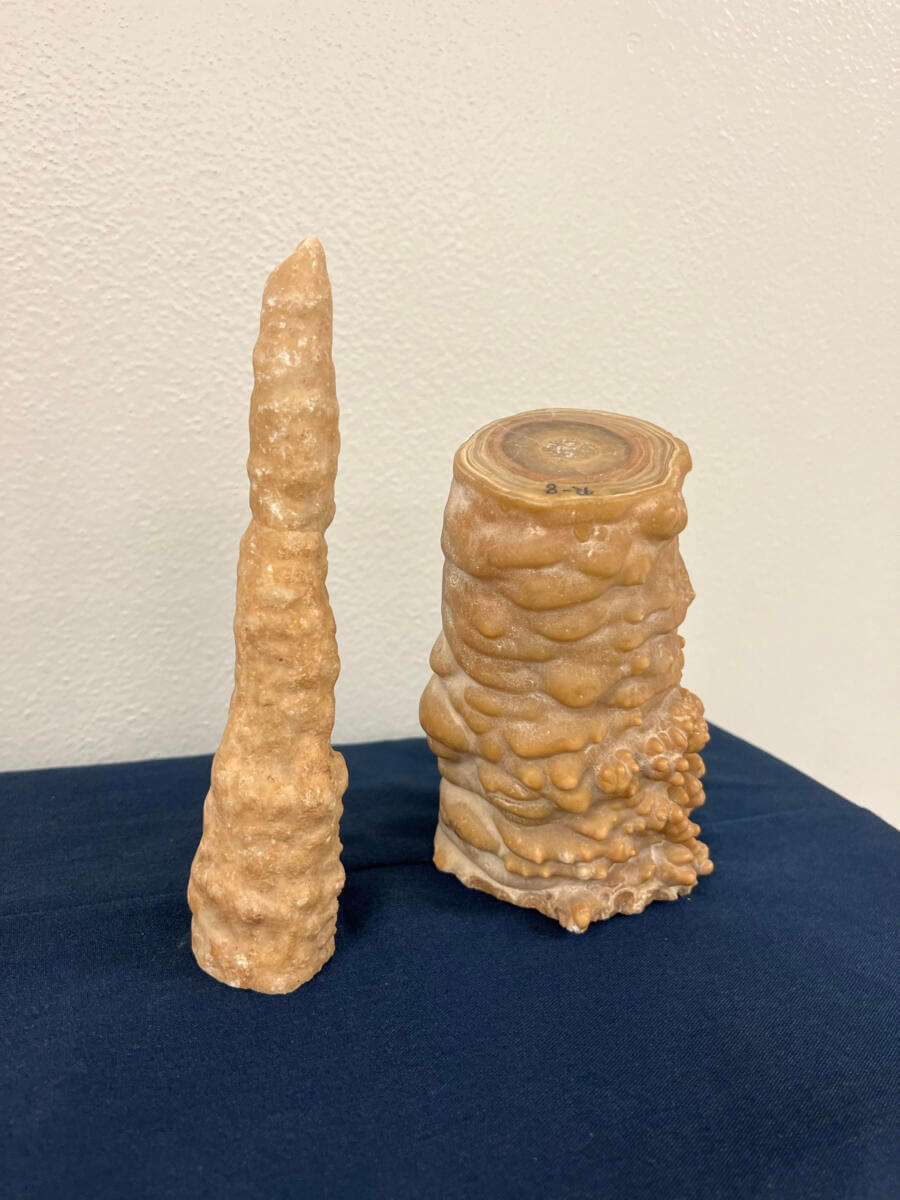
A stalagmite is a type of rock formation that rises from the floor of a cave due to the accumulation of material deposited on the floor from ceiling drippings. Stalagmites are typically composed of calcium carbonate but may consist of lava, mud, peat, pitch, sand, sinter and amber. Stalagmites are found on cave floors; if visited, you are encouraged not to touch the cave walls or formations. The stalagmites may break very easily and even the oil from your hands can cause them to stop growing. Through the Federal Cave Resources Protection Act, some legal penalties and actions will be taken if someone breaks cave formations. These regulations are placed to protect the formations and continue allowing the public to marvel at them for generations to come. (The stalagmites shown here were donated to the Fitzgerald Museum by the landowners more than 30 years ago.)
Stalagmites may be formed for periods ranging from a few hundred years up to one million years. Stalagmites are a valuable tool for establishing the upper limits of sea level positions through time. These formations serve as natural time capsules by preserving evidence of climates and environmental conditions over centuries. The oldest known stalagmite is 2.2 million years old from the Great Basin National Park and the largest known stalagmite in the world exceeds 70 meters (230 ft) in height and is in Sơn Đoòng Cave, Vietnam. You can visit stalagmites at national parks such as Carlsbad Caverns in New Mexico and Wind Cave in South Dakota.
March 2024: Stalagmites
February 2024: Amethyst
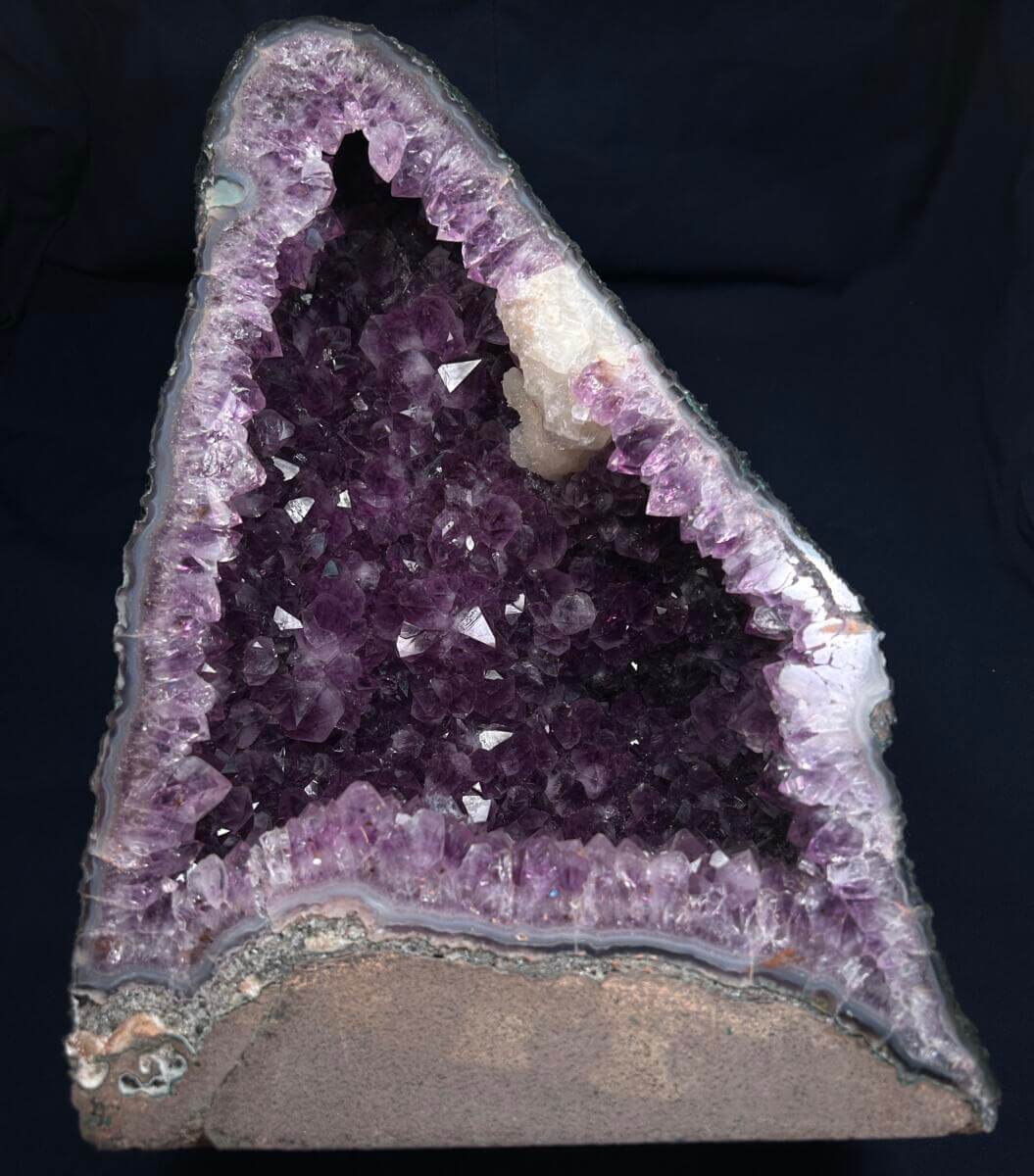

Amethyst is a popular variety of quartz renowned for its purple color that can vary in shades from light lilac to deep violet. This gemstone has a vitreous, or “glass-like” luster, which is how a gem appears when reflecting light. Aside from its gorgeous color and shine, amethyst can be identified by its hardness, which is a 7 on the Mohs scale and hexagonal or rhombohedral prism shape.
Although a more common gemstone, amethyst holds high significance in many cultures all over the world and is a popular stone used in jewelry due to its durability. Thousands of years ago Ancient Egyptians used amethyst to carve animal statues and amulets as a sign of status and that were believed to possibly bring protection to the user. Even its name comes from the Ancient Greek word, amethystos, meaning “not drunk” that comes from the mythos that if a person had an amethyst crystal in their mouth they would be protected from intoxication.
To learn more about amethyst and other quartz varieties visit our Fitzgerald Earth Science Museum or the International Gem Society website.
February 2024: Amethyst
January 2024: Spherulitic Structure in Igneous Rock
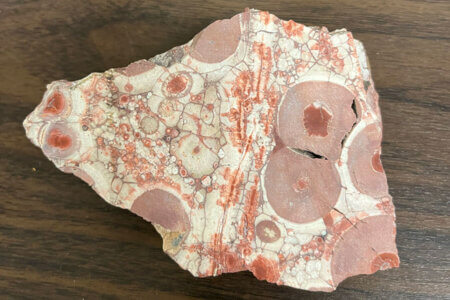
Spherulitic aggregates (spherulites) are radiating arrays of fibrous, needle-like, or acicular crystals that are common in glassy felsic volcanic rocks. Spherulitic structures result from an intergrowth of quartz and orthoclase.
These spherical bodies are thought to have formed as a consequence of rapid mineral growth after nucleation, possibly on an accumulation of volatiles, which is found in magma.
Early descriptions of spherulites are by Cross and Iddings in 1891 and by Harker in 1901. Spherulitic structures in igneous rock offer valuable insights into the complex processes that occur during volcanic eruptions and magma crystallization. These radiating aggregates, consisting of fibrous or acicular crystals, provide a visual record of the dynamic conditions within volcanic environments. The intergrowth of quartz and orthoclase in spherulites reflects the intricate interplay of minerals during cooling and solidification. The presence of spherulites in felsic volcanic rocks suggests that these unique structures may hold clues about the origin and evolution of magmas, shedding light on the history of Earth’s geology. If you would like to find more igneous rocks and their different structures, you can check out the Natural History Museum In South Kensington.
January 2024: Spherulitic Structure in Igneous Rock
December 2023: Chalcopyrite with Dolomite and Bornite
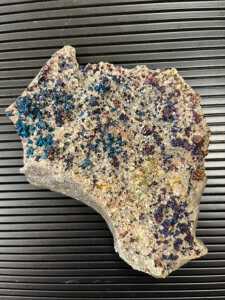
A chalcopyrite, which is the base of this specimen, is a metallic copper iron sulfide material that occurs in nearly all sulfide deposits. It was first introduced by Hackel in 1725 and is often confused with pyrite but is distinguishable through its hardness and iridescent tarnish. Chalcopyrite is a common mineral found in ore veins deposited at medium and high temperatures.
Dolomite, which can be found right on top of the chalcopyrite when looking at the specimen, is a type of limestone that is rich in magnesium, carbonate and calcium carbonate. Dolomite can be found in warm, shallow, marine environments and can form shells around other minerals. This mineral can be identified through its crystals that are colorless or white and seem to be translucent or opaque.
The final mineral found in this specimen that is placed on top of the dolomite is bornite. Bornite is known as peacock ore which is a sulfide mineral. The ore crystalizes as a bronzy dull color but rapidly tarnishes in air to iridescent colors as shown in the image. This mineral is found in igneous, metamorphic and sedimentary rocks with enriched zones of many sulfide mineral deposits. While this specimen was found in the Michigan Sweetwater Mine. you can find more minerals like this at the Smithsonian National Museum of Natural History.
December 2023: Chalcopyrite with Dolomite and Bornite
November 2023: Herbarium
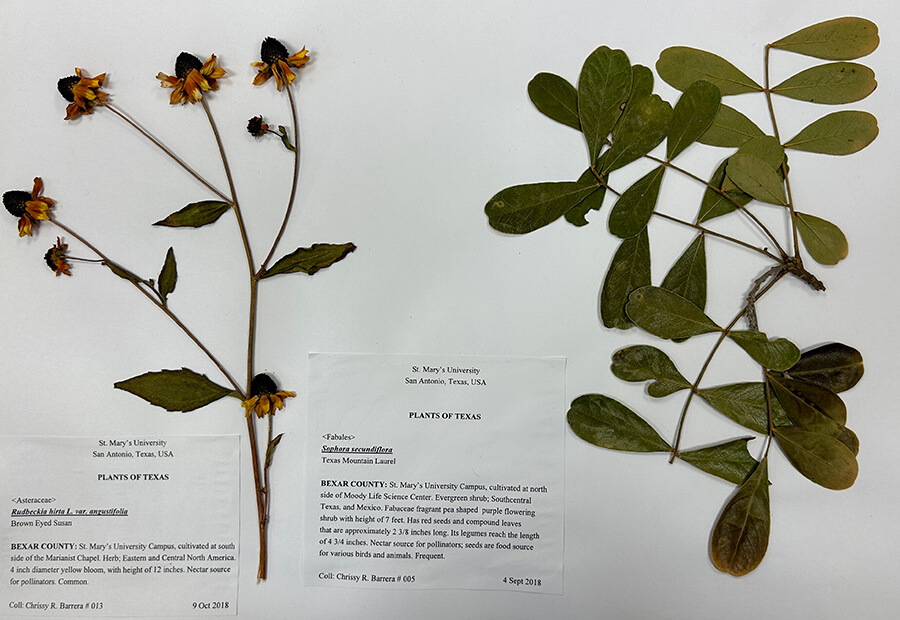
Herbarium specimens, as seen above, are methodically arranged dried plants that have been pressed and mounted on paper. Collections of these preserved plant specimens make up herbaria, which are used around the world for botanical research.
A well-preserved and well-documented herbarium specimen can give scientists insight into the plant’s geographic distribution, biodiversity of an ecosystem and the climate at the time it was collected.
Since these preserved specimens can last for hundreds of years, they can help us to understand the history of a geographic location, especially with plants that are endangered or extinct. With our current and ever-advancing technology, researchers can even sequence DNA from herbarium specimens to analyze their genetic diversity and evolutionary history (phylogenetics).
The specimens in our museum were collected by previous St. Mary’s students as a part of our Environmental Science courses, but there are many herbarium collections in Texas. To learn more about herbaria visit Fort Worth Botanical Garden, San Antonio Botanical Garden and the Smithsonian Museum of Natural History.
November 2023: Herbarium
October 2023: Stromatolites
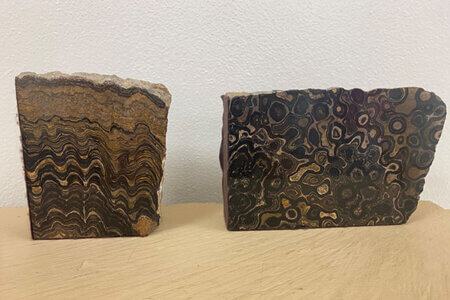
Stromatolites are fossilized algae that first show up in the fossil record during the Precambrian era. During the Precambrian era, the blue-green algae known as cyanobacteria started producing oxygen through photosynthesis, introducing oxygen into the atmosphere and establishing the Ozone layer. This change in our atmosphere led to more stability of Earth’s climate, blocking out higher energy ultraviolet radiation and setting up the right conditions for the Cambrian explosion of life. As single-celled bacteria, they quickly spread and multiplied, often creating microbial mats that promoted the layering of foreign sediments and resulted in the lithification of the sediments to the algae. This pattern led to the layered and patterned fossils identified in the rock record today.
Cyanobacteria once covered the entire planet, but in their photosynthetic activities, they greatly reduced the amount of carbon dioxide in the atmosphere. This led to a cooling of the planet and a reduction of the food supply. These conditions created what is known as the “oxygen catastrophe”, where there was a great abundance of oxygen in the atmosphere produced through photosynthesis, but not enough carbon dioxide to sustain the massive cyanobacteria colonies. Today, while there are many fossil examples of this life form, live stromatolites only exist in four locations in the world: Shark Bay Australia, Cuatrocienegas Basin, Mexico, Lake Bacalar, Mexico and along the coast of South Africa.
October 2023: Stromatolites
September 2023: Crinoids
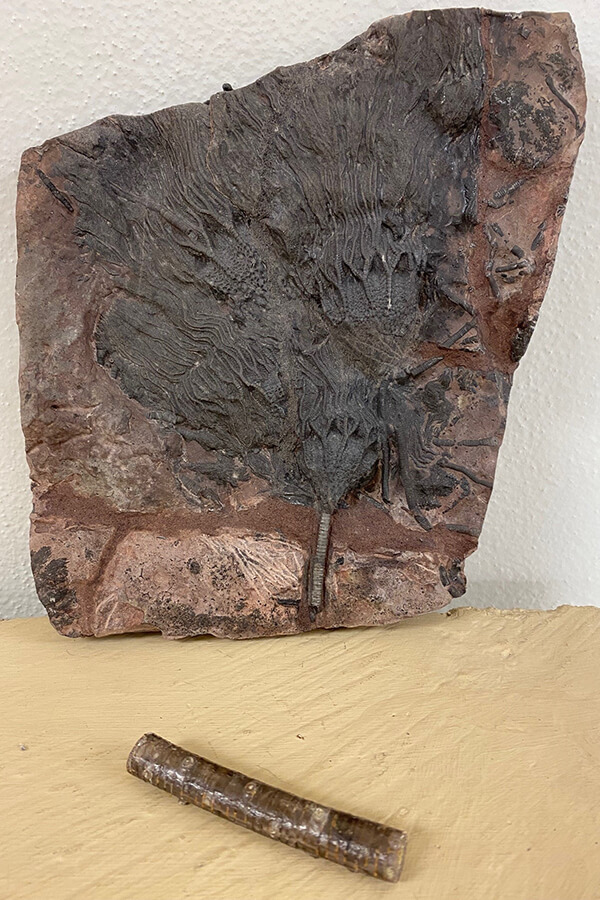
Crinoids, are marine animals that attach to the sea bottom. The variety that have a stalk are commonly referred to as “sea lilies”. These creatures first show up in the fossil record during the mid-Cambrian part of the Paleozoic era and were much larger and prolific at that time then specimens today. Different species of crinoids have been present on the Earth for about 500 million years. You can read more about the history of crinoid evolution here.
Because crinoids grow in marine environments, finding fossils of these animals tells scientists that the rocky areas where they are found were once covered with water. This helps to construct the geologic history of our planet.
The stem pieces, as shown in the front of the image, are the most commonly found portion of the crinoid in the fossil record. The tentacles or “flowers” are typically a rarer find. The other specimen in the image shows multiple flowers and the structure tells us about the type of crinoid. This species is a Scyphocrinites elegans from the Silurian time period. Many of these specimens can be found in modern-day Morocco.
September 2023: Crinoids
August 2023: Dinosaur Footprint Reproductions
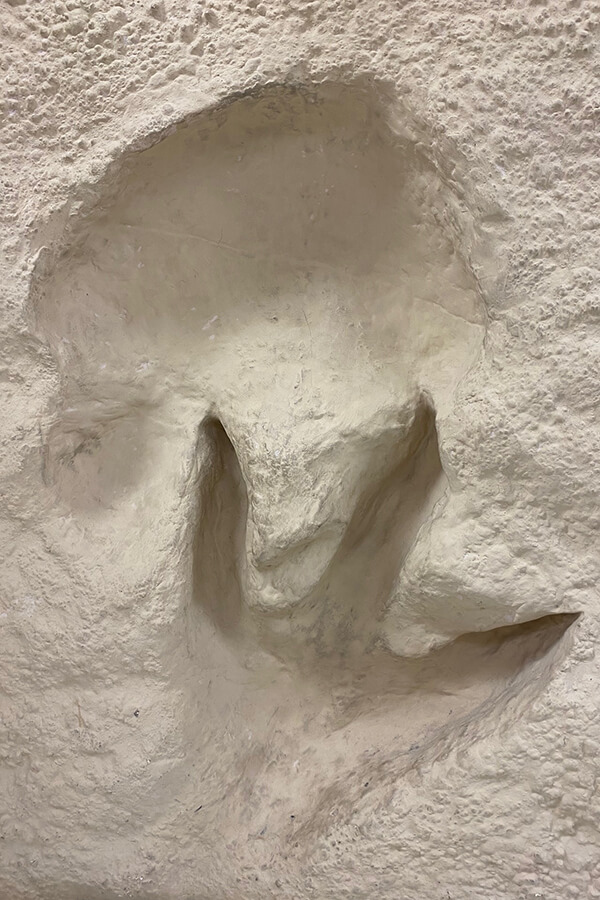
The Fitzgerald Earth Science Museum is fortunate to have on display reproductions made of tracks from two different dinosaur species. The display was created by pouring plaster into two footprints found in the Paluxy River, west of Glen Rose, Texas, to create casts. Two expeditions by St. Mary’s faculty from the Biology Department were made in 1940 to collect the casts. The hardened casts were then used to make new impressions in the plaster base that is on display.
The two tracks seen on the reproduction are from animals that existed around 120 million years ago. The shapes of the different tracks tell a story about what life lived in the area. The rounded impression is from a Sauropod, one of the species of vegetarian gentle giants that roamed the landscape like the well-known Brontosaurus. The three-toed track is made by a bipedal, carnivorous dinosaur similar to a Tyrannosaurus.
Dinosaur tracks such as these can be viewed in a number of locations in Texas, such as Government Canyon State Natural Area, The Heritage Museum of the Texas Hill Country and Dinosaur Valley State Park.
You can also learn more about dinosaurs at the Texas Memorial Museum, the Witte Museum, the Houston Museum of Natural Science and the Perot Museum of Nature and Science.
August 2023: Dinosaur Footprint Reproductions
July 2023: Fungia
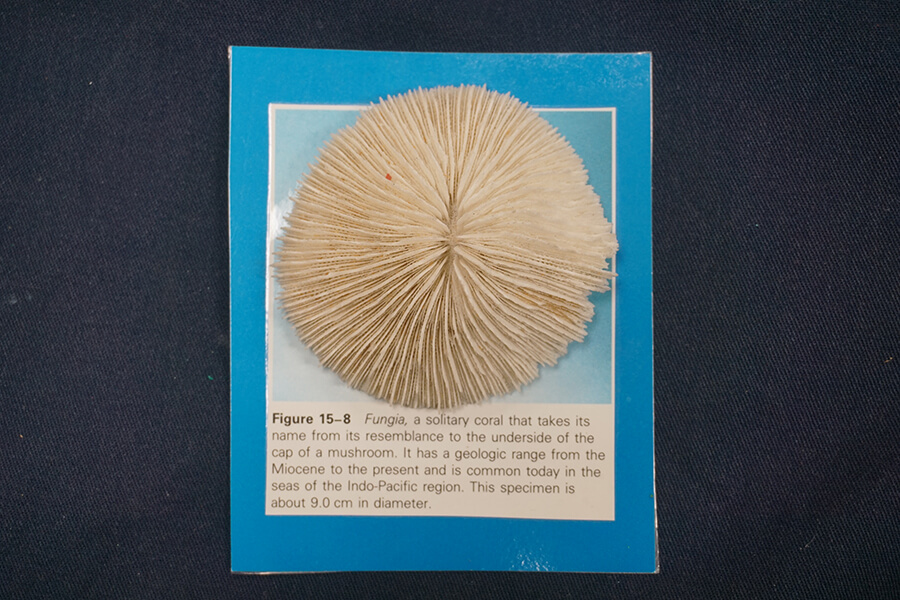
These solitary species live freely amongst the waters and come from the Miocene period. They can be found today in places of the Indo-West Pacific, Western Central Pacific and Western Indian Ocean, as well as the Northwest Pacific. These round plates move often and can move up to 12” per day (30cm). Their movement is carried by the water and currents. The water is also a safety harness for these small creatures as when they are buried under sediments or sand, they fill up their tissues with water to then release it and to be taken with the current as transportation.
Fungia corals are shaped as round disks that have short tentacles that can retract during the day and or the night. They often retract their tentacles themselves when they feel harmed or disturbed. Their mouths are sticking out on top of one another from the center and can have various sizes of mouths. Because there can be exposure to their mouths, a parasite called bivalve gastropod Faungiacava eilatensis lives in their mouths. The fungia often get their sources from small organisms and nutrients from dissolved organic matter.
July 2023: Fungia
June 2023: Great White Shark Tooth
Origin: South Carolina
Species: Carcharodon megalodon
Great white sharks are one of the world’s largest predators alive and evolved from ancient sharks called the Megalodon (Carcharodon or otodus megalodon). This specific specimen originates from the Miocene Epoch, 23.03 to 5.3 million years ago, which was a time of a warmer climate for many years and other animals during this evolution. There was research found on shark population numbers from the Miocene epoch, that questioned a possible wipe-out of nearly 90% of sharks declined by data showing a difference in sediments of shark fossils.
They live in the oceans and are found all around the globe including places in the coastal areas and offshore with water temperatures of 12 to 24 degrees Celsius (54- and 75 degrees Fahrenheit.) High concentrations of the species can be found in the United States, Japan, Oceania, Chile, South Africa and the Mediterranean.
June 2023: Great White Shark Tooth
May 2023: Malachite
Oppenheimer Collection
Origin: Unknown
Mineral Type: Copper carbonate hydroxide
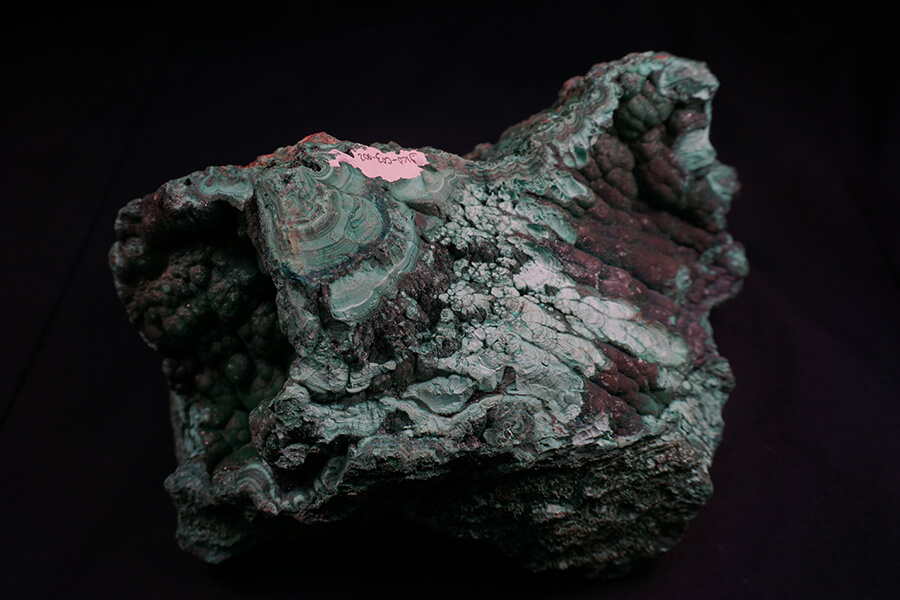
Malachite comes from the oxidizing zone in the shallows of the Earth around copper deposits. They often fall from solutions in caverns, cavities and intergranular spaces of porous rocks. Their composition is mostly of carbonate and copper minerals, so, there are rarely any crystals to be found and are usually acicular and mostly clear. Their gravity range is high from 3.6 to 4.0, meaning that because of this property, the green mineral is easy to identify.
Malachite was first found in areas of Egypt and Israel and over 4000 years ago were they mined for the making of copper. Though they were mainly produced for copper, these days they are not used as often and much of the market on malachite comes from deposits in the Democratic Republic of the Congo, as well as Australia, France and Arizona.
May 2023: Malachite
April 2023: Aragonite
Oppenheimer Collection (Kathi and John Oppenheimer, Law School Class of 68’)
Mineral Type: Carbonate mineral
Location: Australia

The Aragonite photographed above is also a part of the newest addition to the David Fitzgerald J. Museum, the Oppenheimer Collection. Aragonite is a high-pressure polymorph of calcium carbonate; therefore, it occurs in high-pressure metamorphic rock such as those formed in subduction zones.Aragonite are tabular, prismatic or needle-like often with steep pyramidal-shaped ends. Samples can be white, colorless, gray, yellowish, green, blue, reddish, purple or brown. Aragonite provides essential materials for marine life and keeps the pH of the water close to its natural level to prevent the dissolution of biogenic calcium carbonate.
April 2023: Aragonite
March 2023: Brush Coral
Acropora Hyacinthus
Location: Unknown

Brush coral is the most abundant coral of exposed outer reef slopes and is mostly found in the upper reef slopes and outer reef flats. Brush corals are grouped in colonies which can be observed as wide flat plates and tables or tiered aggregations of small plates. Branchlets are thin and finely structured except when exposed to wave action, which then become closely fused. Branchlets are fine and upward-projecting. It is thought to have a range that includes the Indian Ocean, the Indo-Pacific waters, southeast Asia, Japan, the East China Sea and the western Pacific Ocean. Figures of its population are unknown, but it is likely to be threatened by the global reduction of coral reefs and the increase in temperature causing coral bleaching. The image shown above shows the physical consequences of coral bleaching in which the colorful appearance of coral is taken away, leaving a white cast as seen in this sample.
March 2023: Brush Coral
February 2023: Fluorite
Oppenheimer Collection (Kathi and John Oppenheimer, Law School Class of 68’)
Mineral Type: Fluorite
Location: Blanchard Mine, New Mexico
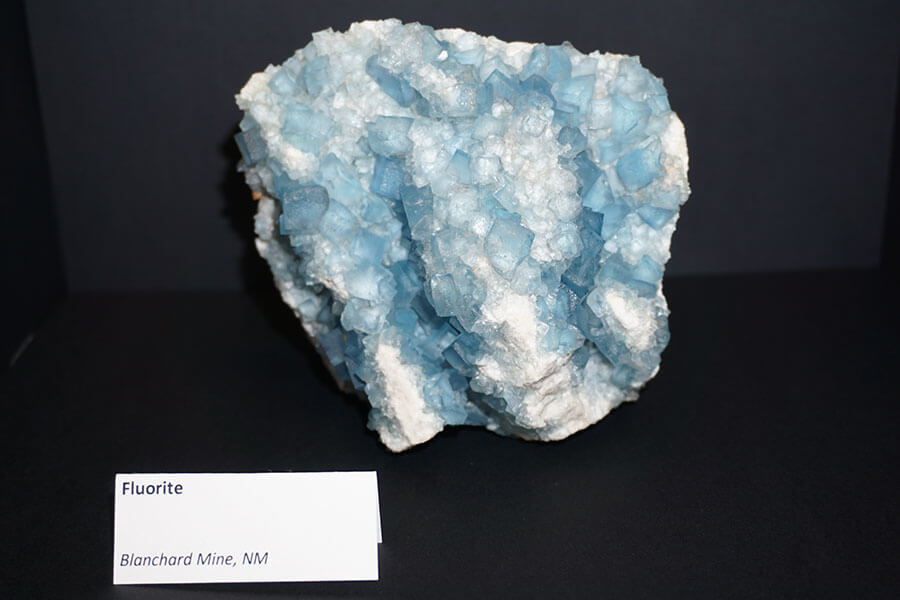
The Fluorite pictured is a part of the Oppenheimer Collection, found in Blanchard Mine, New Mexico. Fluorites are mainly found in hydrothermal veins.
Fluorites are pore-filling materials found in carbonate rocks like limestone and dolostones. When it comes to the hydrothermal veins, they are through low and high-temperature hydrothermal fluids and can be rich in fluorite. They can be found all over the world in different places. As well as other minerals in granites, greisen, pegmatites and other veins with higher temperatures.
The mineral itself is made up of calcium fluoride. It can come in different colors and sizes. Some common colors of Fluorite are purple, blue, brown, gold, yellow and lilac. Fluorite can be used for many different things such as flux or smelting for varieties of chemical, metallurgical and ceramic processes.
As far as manufacturing goes, Fluorite was used to manufacture chlorofluorocarbons (CFCs) for refrigerants and aerosol sprays. Recent studies have shown that it has contributed to concerns about CFCs’ impact of the Earth’s ozone layer.

